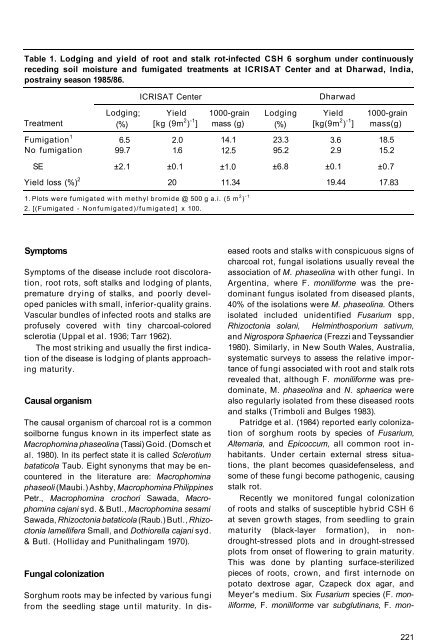Sorghum Diseases in India
Sorghum Diseases in India
Sorghum Diseases in India
You also want an ePaper? Increase the reach of your titles
YUMPU automatically turns print PDFs into web optimized ePapers that Google loves.
Table 1. Lodg<strong>in</strong>g and yield of root and stalk rot-<strong>in</strong>fected CSH 6 sorghum under cont<strong>in</strong>uously<br />
reced<strong>in</strong>g soil moisture and fumigated treatments at ICRISAT Center and at Dharwad, <strong>India</strong>,<br />
postra<strong>in</strong>y season 1985/86.<br />
Treatment<br />
Fumigation 1<br />
No fumigation<br />
SE<br />
Yield loss (%) 2<br />
ICRISAT Center Dharwad<br />
Lodg<strong>in</strong>g ; Yield<br />
(%) [kg (9m 2 ) -1 ]<br />
6.5<br />
99.7<br />
±2.1<br />
2.0<br />
1.6<br />
±0.1<br />
20<br />
1000-gra<strong>in</strong><br />
mass (g)<br />
14.1<br />
12.5<br />
±1.0<br />
11.34<br />
1. Plots were fumigated with methyl bromide @ 500 g a.i. (5 m 2 ) -1<br />
2. [(Fumigated - Nonfumigated)/fumigated] x 100.<br />
Symptoms<br />
Symptoms of the disease <strong>in</strong>clude root discoloration,<br />
root rots, soft stalks and lodg<strong>in</strong>g of plants,<br />
premature dry<strong>in</strong>g of stalks, and poorly developed<br />
panicles with small, <strong>in</strong>ferior-quality gra<strong>in</strong>s.<br />
Vascular bundles of <strong>in</strong>fected roots and stalks are<br />
profusely covered with t<strong>in</strong>y charcoal-colored<br />
sclerotia (Uppal et al. 1936; Tarr 1962).<br />
The most strik<strong>in</strong>g and usually the first <strong>in</strong>dication<br />
of the disease is lodg<strong>in</strong>g of plants approach<strong>in</strong>g<br />
maturity.<br />
Causal organism<br />
The causal organism of charcoal rot is a common<br />
soilborne fungus known <strong>in</strong> its imperfect state as<br />
Macrophom<strong>in</strong>a phaseol<strong>in</strong>a (Tassi) Goid. (Domsch et<br />
al. 1980). In its perfect state it is called Sclerotium<br />
bataticola Taub. Eight synonyms that may be encountered<br />
<strong>in</strong> the literature are: Macrophom<strong>in</strong>a<br />
phaseoli (Maubi.) Ashby, Macrophom<strong>in</strong>a Philipp<strong>in</strong>es<br />
Petr., Macrophom<strong>in</strong>a crochori Sawada, Macrophom<strong>in</strong>a<br />
cajani syd. & Butl., Macrophom<strong>in</strong>a sesami<br />
Sawada, Rhizoctonia bataticola (Raub.) Butl., Rhizoctonia<br />
lamellifera Small, and Dothiorella cajani syd.<br />
& Butl. (Holliday and Punithal<strong>in</strong>gam 1970).<br />
Fungal colonization<br />
<strong>Sorghum</strong> roots may be <strong>in</strong>fected by various fungi<br />
from the seedl<strong>in</strong>g stage until maturity. In dis<br />
Lodg<strong>in</strong>g<br />
(%)<br />
23.3<br />
95.2<br />
±6.8<br />
Yield<br />
[kg(9m 2 ) -1 ]<br />
3.6<br />
2.9<br />
±0.1<br />
19.44<br />
1000-gra<strong>in</strong><br />
mass(g)<br />
18.5<br />
15.2<br />
±0.7<br />
17.83<br />
eased roots and stalks with conspicuous signs of<br />
charcoal rot, fungal isolations usually reveal the<br />
association of M. phaseol<strong>in</strong>a with other fungi. In<br />
Argent<strong>in</strong>a, where F. moniliforme was the predom<strong>in</strong>ant<br />
fungus isolated from diseased plants,<br />
40% of the isolations were M. phaseol<strong>in</strong>a. Others<br />
isolated <strong>in</strong>cluded unidentified Fusarium spp,<br />
Rhizoctonia solani, Helm<strong>in</strong>thosporium sativum,<br />
and Nigrospora Sphaerica (Frezzi and Teyssandier<br />
1980). Similarly, <strong>in</strong> New South Wales, Australia,<br />
systematic surveys to assess the relative importance<br />
of fungi associated with root and stalk rots<br />
revealed that, although F. moniliforme was predom<strong>in</strong>ate,<br />
M. phaseol<strong>in</strong>a and N. sphaerica were<br />
also regularly isolated from these diseased roots<br />
and stalks (Trimboli and Bulges 1983).<br />
Patridge et al. (1984) reported early colonization<br />
of sorghum roots by species of Fusarium,<br />
Alternaria, and Epicoccum, all common root <strong>in</strong>habitants.<br />
Under certa<strong>in</strong> external stress situations,<br />
the plant becomes quasidefenseless, and<br />
some of these fungi become pathogenic, caus<strong>in</strong>g<br />
stalk rot.<br />
Recently we monitored fungal colonization<br />
of roots and stalks of susceptible hybrid CSH 6<br />
at seven growth stages, from seedl<strong>in</strong>g to gra<strong>in</strong><br />
maturity (black-layer formation), <strong>in</strong> nondrought-stressed<br />
plots and <strong>in</strong> drought-stressed<br />
plots from onset of flower<strong>in</strong>g to gra<strong>in</strong> maturity.<br />
This was done by plant<strong>in</strong>g surface-sterilized<br />
pieces of roots, crown, and first <strong>in</strong>ternode on<br />
potato dextrose agar, Czapeck dox agar, and<br />
Meyer's medium. Six Fusarium species (F. moniliforme,<br />
F. moniliforme var subglut<strong>in</strong>ans, F. mon-<br />
221








